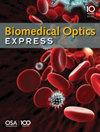Preserving shape details of pulse signals for video-based blood pressure estimation
IF 3.2
2区 医学
Q2 BIOCHEMICAL RESEARCH METHODS
引用次数: 0
Abstract
In recent years, imaging photoplethysmograph (iPPG) pulse signals have been widely used in the research of non-contact blood pressure (BP) estimation, in which BP estimation based on pulse features is the main research direction. Pulse features are directly related to the shape of pulse signals while iPPG pulse signals are easily disturbed during the extraction process. To mitigate the impact of pulse feature distortion on BP estimation, it is necessary to eliminate interference while retaining valuable shape details in the iPPG pulse signal. Contact photoplethysmograph (cPPG) pulse signals measured at rest can be considered as the undisturbed reference signal. Transforming the iPPG pulse signal to the corresponding cPPG pulse signal is a method to ensure the effectiveness of shape details. However, achieving the required shape accuracy through direct transformation from iPPG to the corresponding cPPG pulse signals is challenging. We propose a method to mitigate this challenge by replacing the reference signal with an average cardiac cycle (ACC) signal, which can approximately represent the shape information of all cardiac cycles in a short time. A neural network using multi-scale convolution and self-attention mechanisms is developed for this transformation. Our method demonstrates a significant improvement in the maximal information coefficient (MIC) between pulse features and BP values, indicating a stronger correlation. Moreover, pulse signals transformed by our method exhibit enhanced performance in BP estimation using different model types. Experiments are conducted on a real-world database with 491 subjects in the hospital, averaging 60 years of age.在基于视频的血压估算中保留脉搏信号的形状细节
近年来,成像血压计(iPPG)脉搏信号被广泛应用于非接触式血压(BP)估算研究,其中基于脉搏特征的血压估算是主要研究方向。脉搏特征与脉搏信号的形状直接相关,而 iPPG 脉搏信号在提取过程中容易受到干扰。为了减轻脉冲特征失真对血压估计的影响,有必要在消除干扰的同时保留 iPPG 脉冲信号中有价值的形状细节。在静止状态下测量的接触式血压计(cPPG)脉冲信号可视为未受干扰的参考信号。将 iPPG 脉冲信号转换为相应的 cPPG 脉冲信号是确保形状细节有效性的一种方法。然而,通过将 iPPG 脉冲信号直接转换为相应的 cPPG 脉冲信号来达到所需的形状精度具有挑战性。我们提出了一种减轻这一挑战的方法,即用平均心动周期(ACC)信号代替参考信号,该信号可在短时间内近似代表所有心动周期的形状信息。我们开发了一种使用多尺度卷积和自我注意机制的神经网络来进行这种转换。我们的方法显著提高了脉搏特征与血压值之间的最大信息系数(MIC),表明两者之间的相关性更强。此外,通过我们的方法转换的脉搏信号在使用不同模型类型进行血压估计时表现出更强的性能。实验是在一个真实世界的数据库中进行的,该数据库中有 491 名平均年龄为 60 岁的医院受试者。
本文章由计算机程序翻译,如有差异,请以英文原文为准。
求助全文
约1分钟内获得全文
求助全文
来源期刊

Biomedical optics express
BIOCHEMICAL RESEARCH METHODS-OPTICS
CiteScore
6.80
自引率
11.80%
发文量
633
审稿时长
1 months
期刊介绍:
The journal''s scope encompasses fundamental research, technology development, biomedical studies and clinical applications. BOEx focuses on the leading edge topics in the field, including:
Tissue optics and spectroscopy
Novel microscopies
Optical coherence tomography
Diffuse and fluorescence tomography
Photoacoustic and multimodal imaging
Molecular imaging and therapies
Nanophotonic biosensing
Optical biophysics/photobiology
Microfluidic optical devices
Vision research.
 求助内容:
求助内容: 应助结果提醒方式:
应助结果提醒方式:


